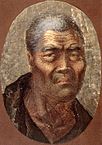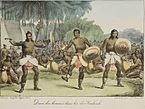Louis Choris
In this article, we will explore the topic of Louis Choris from different perspectives. We will delve into its history, analyze its impact on today's society and discuss possible future implications. Louis Choris has captured the interest of academics, experts and enthusiasts alike, generating passionate debates and generating a wide spectrum of opinions. Throughout these pages, we will immerse ourselves in an exhaustive analysis that seeks to shed light on the most relevant aspects of Louis Choris, with the aim of providing the reader with a complete and enriching vision of this fascinating topic.

Louis Choris (1795–1828) was a German-Russian painter and explorer.
Biography
Louis Choris was born in Yekaterinoslav, Russian Empire, now Dnipro, Ukraine to German-Russian parents on March 22, 1795. In 1816, he visited the Pacific and the west coast of North America on board the Russian expeditionary ship Rurik, serving as an artist with the Romanzoff expedition under the command of Lieutenant Otto von Kotzebue, which was tasked with exploring a northwest passage.

In terms of his work as an artist, Choris is said to have "painted nature as he found it. The essence of his art is truth; a fresh, vigorous view of life, and an originality in portrayal." His illustrations on the Romanzoff expedition are therefore likely to faithfully represent the subjects he painted. After the voyage of the Rurik, Choris went to Paris where he issued a portfolio of his drawings in lithographic reproduction and studied in the ateliers of Gerard and Regnault. Choris worked extensively in pastels and documented the Ohlone people in the missions of San Francisco, California in 1816. Choris left France in 1827 for South America and was killed by robbers on March 22, 1828, en route to Vera Cruz, Mexico.
Choris' works are now held in public collections by such museums as the Anchorage Museum of History and Art, the Honolulu Museum of Art and the Oakland Museum of California.
Legacy
Otto von Kotzebue named the Choris Peninsula after Choris.
References
- ^ a b "Louis Choris". The Bancroft Library - University of California
- ^ https://imagesofoldhawaii.com/hawaii-as-seen-by-an-artist-in-1816
- ^ San Francsico One Hundred Years Ago - Translated From the French of Louis Choris By Porter Garnett, Retrieved 2007-04-07.
- ^ "Geographic Names Information System". edits.nationalmap.gov. Retrieved 2023-01-05.
Literature
- Daum, Andreas W., German Naturalists in the Pacific around 1800: Entanglement, Autonomy, and a Transnational Culture of Expertise. In Explorations and Entanglements: Germans in Pacific Worlds from the Early Modern Period to World War I, ed. Hartmut Berghoff et al. New York, Berghahn Books, 2019, 70‒102.
- Ellis, George R., Honolulu Academy of Arts, Selected Works, Honolulu, Honolulu Academy of Arts, 1990, 181.
- Forbes, David W., Encounters with Paradise: Views of Hawaii and its People, 1778–1941, Honolulu Academy of Arts, 1992, 23–62.
Gallery
-
Kamehameha, King of the Sandwich Islands, pen and watercolor by Louis Choris, 1816, Honolulu Museum of Art
-
Kaahumanu, Woman of the Sandwich Islands, pen, ink wash and watercolor by Louis Choris, 1816, Honolulu Museum of Art
-
Interior of a House of a Chief of the Sandwich Islands by Louis Choris, pen, watercolor and gouache, 1816, Honolulu Academy of Arts
-
Men's dance in the Sandwich Islands, by Louis Choris, 1816, published 1822, National Library of New Zealand
-
Ohlone Indians in a Tule Boat in the San Francisco Bay, by Louis Choris, 1816, published 1822
-
A Chukchi family in front of their home near the Bering strait. Drawing by Louis Choris in summer 1816.
-
Port of Honolulu as seen Louis Choris in 1816






